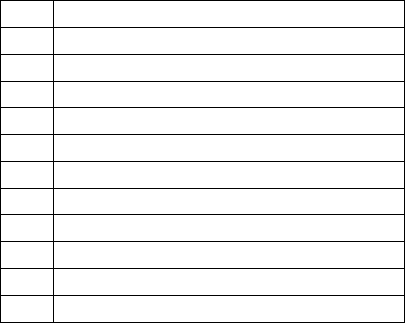
College Algebra II
MATH 0098
3 credits
Description: The topics covered in college algebra II are functions—linear, radical,
quadratic, exponential, and logarithmic—and their graphs, rational expressions, linear
and compound inequalities, rational exponents, solving systems of linear equations,
and solving quadratic equations. This course does not meet the mathematics
competency at the Pittsburgh campus.
Prerequisite: None
Textbook: The recommended text for the course is Introductory & I ntermediate Algebra
for college students, Blitzer, R., 4th Edition, Pearson/Prentice Hall, 2009.
Other textbooks will be considered by the faculty liaison on case-by-case basis.
The following topics should be covered in this course:
1. Rational Expressions
2. Functions
3. Inequalities
4. Radicals and Rational Exponents
5. Quadratic Equations
6. Exponential and Logarithmic Functions
Course objectives: Upon completion of this course, students will be able to do the
following:
Rational Expressions (7.1-7.4)
1. Simplify rational expressions
2. Find real numbers for which rational expressions are undefined
3. Multiply and divide simple rational expressions
4. Add and subtract simple rational expressions
Basics of Functions (8.1-8.4)
1. Find the domain and range of relations and functions
2. Identify functions
3. Evaluate functions
4. Find the sum, difference, product, and quotient of functions
5. Form com posite functions
6. Find and verify inverse functions
Inequalities and Problem Solving (9.1-9.4)
1. Use linear inequalities to solve problems involving revenue, cost, and profit
2. Solve compound inequalities involving and
3. Solve compound inequalities involving or
4. Solve equations involving absolute value
5. Solve inequalities involving absolute value
6. Graph linear inequalities in two variables
Radicals, Radical Functions, and Rational Exponents (10.1-10.7)
1. Evaluate square roots and square root functions
2. Simplify expressions involving radicals
3. Add, subtract, multiply, and divide radical expressions
4. Solve equations involving radicals
5. Express square roots of negative radicands in terms of
i
6. Perform operations on complex numbers
Quadratic Equations and Functions, and Inequalities (11.1-11.5)
1. Solve quadratic equations using the square root property, completing the
square, and the quadratic formula
2. Find the distance between two points using the square root property
3. Graph quadratic functions of the forms
fx()= a( x- h)
2
+ k
and
fx()= ax
2
+ bx+ c
4. Find the maximum or the minimum of a quadratic function
5. Solve quadratic and rational inequalities
Exponential and Logarithmic Functions (12.1-12.4)
1. Evaluate exponential functions
2. Graph exponential functions
3. Find compound interest and interest compounded continuously
4. Change from exponent ial to logarithmic form and vice versa
5. Use the properties of logarithms to expand and condense logarithmic
expressions
6. Solve logarithmic and exponential equations
Grading: The final grade will be determined using a variety of assessment methods
including homework, quizzes and exams.
Pitt Grading System:
All courses required to satisfy associate and baccalaureate degree requirements-
including all courses required for a major, a minor, or general education-must be
taken for letter grades, with the exception of those courses designated as graded S and
NC only. Pitt-Bradford uses 13 earned letter grades. They are listed below with their
equivalent quality point values.

A+
4.00
A
4.00 superior achievement
A-
3.75
B+
3.25
B
3.00 meritorious achievement
B-
2.75
C+
2.25
C
2.00 adequate achievement
C-
1.75
D+
1.25
D
1.00 minimal achievement
F
0.00 failure
Academic Integrity and Plagiarism: Members of a university community, both faculty
and students, bear a serious responsibility to uphold personal and professional
integrity and to maintain complete honesty in all academic work. Violations of the code
of academic integrity are not tolerated. Students who cheat or plagiarize or who
otherwise take improper advantage of the work of others face harsh penalties, including
permanent dismissal. The academic integrity guidelines set forth student and faculty
obligations and the means of enforcing regulations and addressing grievances.
Grades:
Grade
criteria
in
the
high
school
course
may
be
different
from
the
University
standards.
A C
HS st
udent
could recei
ve two course grades,
one for
high sch
ool
and on
e
for the University transcript. In most cases,
the grades are the same.
Grading standards
should b
e explained at
the beginning of
the course.
Transfer
Credits:
Grades
earned
in
CHS
courses
appear
on
an
official
University
of
Pittsburgh transcript
and the
course
credits
may
be
eligible
for
transfer
to other
colleges
and universities.
Students should contact
potential
colleges and universities in
advance
to be sure their CHS credits will be accepted. If students will attend any University of
Pittsburgh campus,
grade
earned in the
course
will
count
toward the student grade
point
average
at
the
University.
At
the
University
of
Pittsburgh,
the
CHS course
supersedes any equivalent
AP cred
it.
Drops
and
Withdrawals:
Students
should monitor
their
progress
in a
course.
A CHS
teacher can contact the program
administrators to request
a drop or
withdrawal.
Dropping
or
withdrawing
from
the
CHS
course
has
no
effect
on
enrollment
in
the
high
school
credits.
